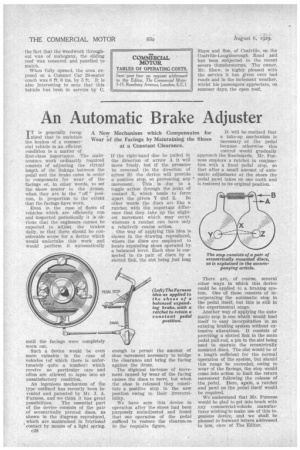An Automatic Brake Adjuster
Page 50

If you've noticed an error in this article please click here to report it so we can fix it.
ITis generally recognized that to maintain the brakes of a commercial vehicle in an efficient condition is a matter of
first-class importance. The maintenance work ordinarily required consists of adjusting the virtual length of the linkage between the Pedal and the brake cams in order to compensate for wear of the facings or, in other words, to set the shoes nearer to the drums,
when they are in the " off " Position, in proportion to tile extent that the facings have worn.
Even in the case of fleets of vehicles which are efficiently run and inspected periodically it is obvious that the engineers cannot be expected to adjust the brakes daily, so that there should be considerable scope for a device which would undertake this work and would perform it automatically until the facings were completely worn out, Such a device would be even more valuable in the case of vehicles (of which there is unfortunately quite a number) which receive no particular care and often are allowed to lapse into an unsatisfactory condition. An ingenious mechanism of the type outlined has recently been invented and patented by Mr. J. A. Furness, and we think it has great possibilities. The essential part of the device consists of the pair of eccentrically pivoted discs, as shown in the diagram reproduced, which are maintained in frictional ' contact by means of a light spring.
C28
If the right-hand disc be pulled in the direction of arrow A it will move freely, but if the pressure be reversed (in the direction of arrow B) the .devicewill provide a -positive stop, so preventing any • movement. . This is due to a toggle action through the point of contact X, which tends to force apart the pivots T and Z. In other words the discs act like a ratchet with the important difference that they take up the slightest movement which may occur, whereas a ratchet can have only a relatively coarse action.
One way of applying this idea is shown in the drawing reproduced, where . the discs are employed to locate expanding shoes operated by a balanced lever. Each shoe is connected to its pair of discs by a slotted link, the slot being just long
enough to permit the amount of shoe movement necessary to bridge the clearance and bring the facing against the drum.
The slightest increase of movement caused by wear of the facing causes the discs to move, but when the shoe is released they constitute a positive stop in the new position owing to their irreversibility.
We have seen this device in operation after the shoes had been purposely maladjusted and found that one operation of the pedal sufficed to restore the clearances to the requisite figure. It will be realized that a take-up mechanism is necessary at . the pedal because otherwise this control would gradually approach the floorboards. Mr. Furness employs a ratchet in conjunction with a fixed pedal stop, so that after a small amount of automatic adjustment at the shoes the Pedal pawl takes up one tooth and is restored to its original position.
There are, of course, several other ways in Which this device could be applied to a braking system, One of these consists of incorporating the autOmatic stop in the pedal itself, but this is still in the experimental stage.
Another way of applying the automatic stop is one whiCh. would lend itself to easy incorporation in an existing braking system without extensive alterations. It consists of providing a slotted link in the main Pedal pull-rod, a pin in the slOt being used to operate the eccentrically mounted discs. The slot would be of a length sufficient for the normal operation of the system, but should this range be exceeded, owing to wear of the facings, the stop would come into action to limit the return movement following the release of the Pedal. Here, again, a ratchet and pawl on the pedal itself would be required.
We understand that Mr. Furness would be glad to get into touch with any commercial-vehicle manufacturer wishing to make use of this ingenious device, and we shall be pleased to forward letters addressed to him, care of The Editor.














































































































